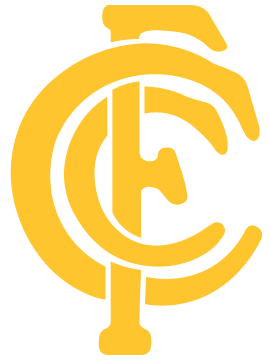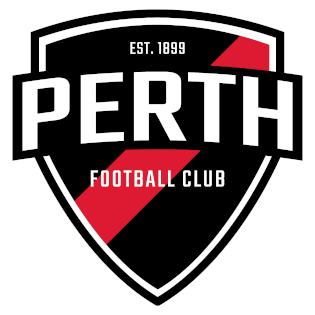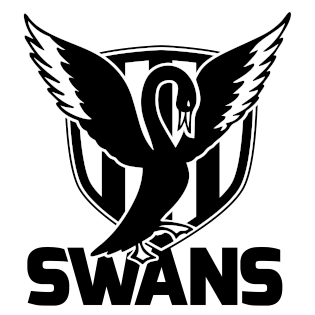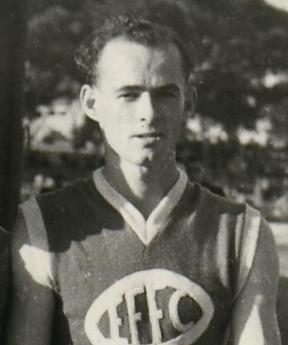Related Research Articles

The West Australian Football League is an Australian rules football league based in Perth, in Western Australia. The league currently consists of ten teams, which play each other in a 20-round season usually lasting from April to September, with the top five teams playing off in a finals series, culminating in a Grand Final. The league also runs reserves, colts (under-19) and women's competitions.
Haydn Austin Bunton is a former Australian rules footballer and coach. The son of the legendary Haydn Bunton Sr., Bunton Jr. played for North Adelaide and Norwood in the South Australian National Football League (SANFL), as well as Swan Districts and Subiaco in the Western Australian National Football League (WANFL).

The Claremont Football Club, nicknamed Tigers, is an Australian rules football club based in Claremont, Western Australia, that currently plays in the West Australian Football League (WAFL) and WAFL Women's (WAFLW). Its official colours are navy blue and gold. Formed as the "Cottesloe Beach Football Club" in 1906, the club entering the WAFL in 1925 as the "Claremont-Cottesloe Football Club"', changing its name to the present in 1935. Claremont have won 12 senior men's premierships since entering the competition, including most recently the 2011 and 2012 premierships.

The Perth Football Club, nicknamed the Demons, is an Australian rules football club based in Lathlain, Western Australia, currently playing in the West Australian Football League (WAFL).

The Swan Districts Football Club, nicknamed the Swans, is an Australian rules football club playing in the West Australian Football League (WAFL) and WAFL Women's (WAFLW). The club is based at Bassendean Oval, in Bassendean, an eastern suburb of Perth, Western Australia. The club was formed in 1933, and joined the then-Western Australian National Football League (WANFL) in 1934, acting as a successor to the Midland Junction Football Club, which had disbanded during World War I, in the Perth Hills region.
Warren James Ralph is a former Australian rules footballer who played during the 1980s with great success as a full-forward for Claremont in the WAFL and with lesser success in the VFL and SANFL.
Graham Thomas Melrose is a former Australian rules footballer who played for the North Melbourne Football Club in the Victorian Football League (VFL) as well as for the East Fremantle Football Club and the Swan Districts Football Club in the Western Australian Football League (WAFL).

James Francis Conway was an Australian rules football player and coach. The winner of the 1950 Sandover Medal, Conway played 180 games for East Fremantle in the Western Australian National Football League (WANFL) between 1943 and 1956, also representing Western Australia in 15 interstate matches. In 1964, he was appointed coach of Claremont, a position which he held for five years, until 1968. He was inducted into the West Australian Football Hall of Fame in 2009.
The 1934 WANFL season was the 50th season of the various incarnations of the Western Australian National Football League. Following upon numerous unsuccessful attempts to revive Midland Junction during the 1920s, Bassendean-based Swan Districts were admitted to the competition. The black and whites were more competitive than previous new clubs owing to the presence of a number of players with previous WANFL experience, including Fred Sweetapple from West Perth, captain-coach "Judda" Bee from East Fremantle and Nigel Gorn from South Fremantle, but after five promising campaigns were to endure nineteen open-age seasons without once winning as many matches as they lost.
The 1933 WANFL season was the 49th season of the Western Australian National Football League in its various incarnations. It was the last year of a seven-team senior competition, and saw George Doig, during the second semi-final, become the first player to kick one hundred goals in a season.
The 1932 WANFL season was the 48th season of the Western Australian National Football League. The premiership was won by West Perth for the first time since 1905. The Cardinals’ win ended both a run of four consecutive premierships by East Fremantle, which won its fifth of seven successive minor premierships but lost both finals it played to be eliminated in the preliminary final, and West Perth's longest premiership drought in its history. West Perth's win was highlighted by the success of champion full forward Ted Tyson, who headed the goalkicking with eighty-four goals including a record eight in the Grand Final[a]. Tyson went on to kick an unprecedented 1,203 goals during a twelve-season career with the Cardinals, but their rise from winning only six matches in 1931 was due to the development of second-year defender Max Tetley, the discovery of a third pre-war Cardinal stalwart in Norm McDiarmid,[b] brother of star ruckman Jack, plus further outstanding youngsters Jim Morgan and Bob Dalziell.
The 1931 WANFL season was the 47th season of the Western Australian National Football League and the first under that moniker, having been called the West Australian Football League (WAFL) until 1930.
The 1935 WANFL season was the 51st season of the Western Australian National Football League. The season saw West Perth win the premiership under the coaching of Johnny Leonard; it was the only time in West Perth's history that it won consecutive premierships, preceding a brief but exceptionally steep decline that saw the Cardinals four years later suffer the equal longest losing streak in WA(N)FL history.
The 1936 WANFL season was the 52nd season of the Western Australian National Football League. The most conspicuous features were the rise of Claremont to their first finals appearance since entering the WAFL ten years beforehand after having won only forty of its first 183 games, and the thrilling finals series in which East Perth rose to their first premiership for nine years after holding on to a thrilling struggle for fourth position where all eight clubs were in the running well into August, then winning two finals by a solitary point. In the process the Royals set a record for the most losses by an eventual premiership club in major Australian Rules leagues,[a] but won their last open-age premiership until 1956. The Royals overcame much adversity to win the premiership, including a crippling injury toll and a schedule modified to allow them to tour Victoria, South Australia and Tasmania between 4 July and the first week of August.
The 1937 WANFL season was the 53rd season of the Western Australian National Football League. The season saw numerous notable highlights, including:
- Five players[a] kicked 100 goals, a number equalled in the major leagues of VFL/AFL, VFA/VFL, or SANFL, only in the 1939 VFA season.[b]
- Frank "Scranno" Jenkins won the Sandover Medal in his debut season of senior football with a record high under the 3-2-1 voting system of 34 votes.
- In the second round, East Fremantle broke their own 21-year-old record for the highest score in league history.
- East Perth drew three games in one season, a feat equalled in major Australian Rules Leagues only by VFA club Moorabbin in 1958 and West Perth in 1960. The Royals could easily have drawn a fourth game but for crowd acclamation preventing umpires from hearing the bell against Subiaco on Foundation Day. No senior Australian Rules team at any level is known to have tied four matches in a season, but Geelong’s Under-19s did so in 1971.
- Swan Districts, with Ted Holdsworth kicking at least six goals in each of the first ten games, reached their first finals series in only their fourth WANFL season. Holdsworth was to reach his 100 goals in two fewer games than George Doig took in his 152-goal 1934 season, but concussion and a broken hand eliminated the prospect of a new record.
The 1939 WANFL season was the 55th season of the various incarnations of the Western Australian National Football League. It is best known for West Perth's record losing streak of twenty-seven matches up to the fifteenth round, an ignominy equalled by Peel Thunder in their formative years but never actually beaten. The Cardinals finished with the worst record since Midland Junction lost all twelve games in 1917, and were the first WANFL team with only one victory for twelve seasons. In their only win, champion forward Ted Tyson became the first West Australian to kick over one thousand goals and he just failed to replicate his 1938 feat of leading the goalkicking for a bottom club. Subiaco, despite a second Sandover win from Haydn Bunton won only three matches, and Swan Districts, affected by the loss of star goalkicker Ted Holdsworth to Kalgoorlie, began a long period as a cellar-dweller with a fall to sixth.
The 1940 WANFL season was the 56th season of the various incarnations of the Western Australian National Football League. It saw Claremont win its third consecutive premiership, but its last before returning to the status of cellar-dweller it occupied during its first decade in the WA(N)FL – between 1943 and 1978 Claremont played finals only five times for one premiership. South Fremantle, after a lean period in the middle 1930s, displaced perennial power clubs East Fremantle and East Perth as the Tigers’ Grand Final opponent, and established some of the basis, in spite of three disastrous wartime under-age seasons, for the club's fabled dynasty after the war.
The 1945 WANFL season was the 61st season of the various incarnations of the Western Australian National Football League.
The 1947 WANFL season was the 63rd season of senior football in Perth, Western Australia. With the background of war completely removed, 1947 saw the WANFL begin a golden age of growth dominated by the two Fremantle clubs, West Perth and Perth, who made the league for the following nine seasons a de facto hierarchy led by South Fremantle and West Perth, who respectively won 128 and 121 of their 159 home-and-away matches between 1947 and 1954. Zones with vastly different populations and large unzoned areas allowed these more successful and financially secure clubs to monopolise the leading player talent.
References
- ↑ Poat, Peter, ed. (1980). Football Register. Westralian Publishers and Associates. p. 256.